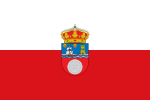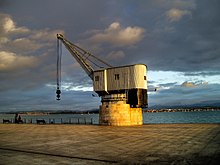Cantabria
|
Comunidad Autónoma de Cantabria ( Spanish ) Cantabria Cantabria |
|||||
|---|---|---|---|---|---|
|
|||||
| Basic data | |||||
| Country : |
|
||||
| Capital : | Santander | ||||
| Area : | 5,321 km² | ||||
| Residents : | 581,078 (January 1, 2019) | ||||
| Population density : | 109.2 inhabitants / km² | ||||
| Expansion: | North – South: approx. 83 km West – East: approx. 137 km |
||||
| Time zone : | UTC +1 | ||||
| ISO 3166-2 : | ES-CB | ||||
| Website : | cantabria.es | ||||
| Politics and administration | |||||
| Autonomy since: | January 11, 1981 | ||||
| President : | Miguel Ángel Revilla Roiz ( PRC ) | ||||
| Representation in the Cortes Generales : |
Congress : 5 seats Senate : 5 seats |
||||
| Structure : | 102 Municipios | ||||
| map | |||||
Cantabria ( Spanish Cantabria ) is an autonomous community on the Cantabrian Sea (Bay of Biscay ) in northern Spain . It is enclosed by the regions of Asturias , Castile-León and Basque Country . The autonomous community consists only of the province of the same name (formerly Santander province ). The capital of Cantabria is the port and industrial city of Santander .
Geography and climate
Cantabria is hilly to mountainous. The highest peaks are in the Picos de Europa , a massif in the Cantabrian Mountains with peaks of over 2000 meters.
The coastal climate in Cantabria is maritime and humid with cool summers and mild winters. In the interior of the country there is partly a mountain climate.
Biggest places
(As of January 1, 2019)
| local community | Residents |
|---|---|
| Santander | 172,539 |
| Torrelavega | 51,494 |
| Castro Urdiales | 32,069 |
| Camargo | 30,260 |
| Piélagos | 25,559 |
| El Astillero | 18,111 |
| Laredo | 11,025 |
| Santa Cruz de Bezana | 13,095 |
| Los Corrales de Buelna | 10,841 |
| Santoña | 11,024 |
| Reinosa | 9.003 |
Population development of the province

history
In the Cueva del Mirón cave near Ramales de la Victoria , the oldest evidence of a burial in the Magdalenian era on the Iberian Peninsula was discovered in 2010 , the 18,700 year old so-called Dama Roja de El Mirón (the “Red Lady from El Mirón ”).
The discovery of the Cabárceno cauldron dates back to the Bronze Age. In ancient times the area was settled by the Cantabrians ( Cantabri ), from whom this region takes its name.
The Cantabrians were ousted by the Visigoths in the 5th century when they conquered the Iberian Peninsula in the course of the Great Migration and founded a Cantabrian duchy with the capital Amaya . But as early as the 8th century, Iberia fell almost entirely under the rule of the Moors , with the exception of Cantabria and Asturias. The Reconquista began from here , and parts of the Cantabrian Mountains were soon back in Christian hands.
Alfonso II defeated the Moorish ruler Hisham I north of Los Barrios de Luna in one of the last battles for Cantabria and drove the Moors into the Meseta . Alfons III eventually founded the Kingdom of Asturias-León. Ferdinand I conquered the region and so it fell to the Kingdom of Castile in the 13th century.
In the early 19th century, the French occupied northern Spain and the Cantabrian Mountains again became the starting point of resistance. The guerrillas waged a successful war against the French occupiers.
economy
Larger industrial areas are located in the capital Santander and the surrounding towns and in the city of Torrelavega, where u. a. larger Solvay , Sniace and Firestone chemical plants are located. The focus of the industrial sector in these two regional centers lies in the processing of raw materials from the region and the neighboring Asturias. Manufacturing factories are located in Santander Bay.
Mining has traditionally also played a major role. In particular zinc , lead and iron ore , but also hard coal, are mined.
In Los Corrales de Buelna , Nissan Motor Ibérica produces engines and transmissions on 132,000 square meters with 681 employees .
The city of Castro Urdiales in the east is part of the greater Bilbao area in the neighboring Basque Country.
The rest of the region is sparsely populated and has a more agricultural character. The industry there mainly deals with the processing of agricultural products. In addition to animal husbandry, fishing and mainly domestic tourism are of economic importance in Cantabria.
In comparison with the GDP of the EU in terms of purchasing power standards, Cantabria achieved an index of 81 (EU-28: 100) (2015). In 2017 the unemployment rate was 13.6%.
With a score of 0.880, Cantabria ranks 9th among the 17 autonomous communities in Spain in the Human Development Index .
Infrastructure
The A8 motorway connects Cantabria with the Basque Country and France to the east and Asturias to the west. In the final stage of construction it will connect France and Portugal. A national road goes via Reinosa to Burgos in Castile-León . Another motorway called “A67” is currently under construction, which branches off from the A8 in Torrelavega and will lead through a high valley via Reinosa to Palencia and is already partially passable.
A railway line operated by the state-owned RENFE runs to Madrid , while the narrow-gauge railway operated by the FEVE company crosses the region from Bilbao to Asturias and Galicia . Since all long-distance routes are only single-tracked and are often used by freight trains, there are only a few daily train connections with long journey times. Only in the greater Santander area is there a rapid-transit S-Bahn network. A high-speed line is planned along the coast of the Cantabrian Sea.
Long-distance bus routes from ALSA serve as a supplement to the thinly timed timetables of the two rail operators.
The main port city is Santander . There is also an airport (IATA code: SDR) with flights to Amsterdam, Brussels, Dublin, Düsseldorf, Frankfurt, Liverpool, London, Milan, Paris, Rome, Alicante, Barcelona, the Canary Islands, Madrid, Málaga, Mallorca, Seville and Valencia.
Web links
- Website of the regional government of Cantabria (Spanish)
- Information on Cantabria - official website for tourism in Spain
Individual evidence
- ↑ Cifras oficiales de población resultantes de la revisión del Padrón municipal a 1 de enero . Population statistics from the Instituto Nacional de Estadística (population update).
- ↑ Nissan production locations in Spain ( Memento of the original from October 24, 2016 in the Internet Archive ) Info: The archive link was inserted automatically and has not yet been checked. Please check the original and archive link according to the instructions and then remove this notice. (PDF; as of 2010).
- ↑ Eurostat. Retrieved April 15, 2018 .
- ↑ Unemployment rate, by NUTS 2 regions. Retrieved November 5, 2018 .
- ^ Sub-national HDI - Area Database - Global Data Lab. Retrieved August 12, 2018 .
Coordinates: 43 ° 18 ′ N , 4 ° 2 ′ W








